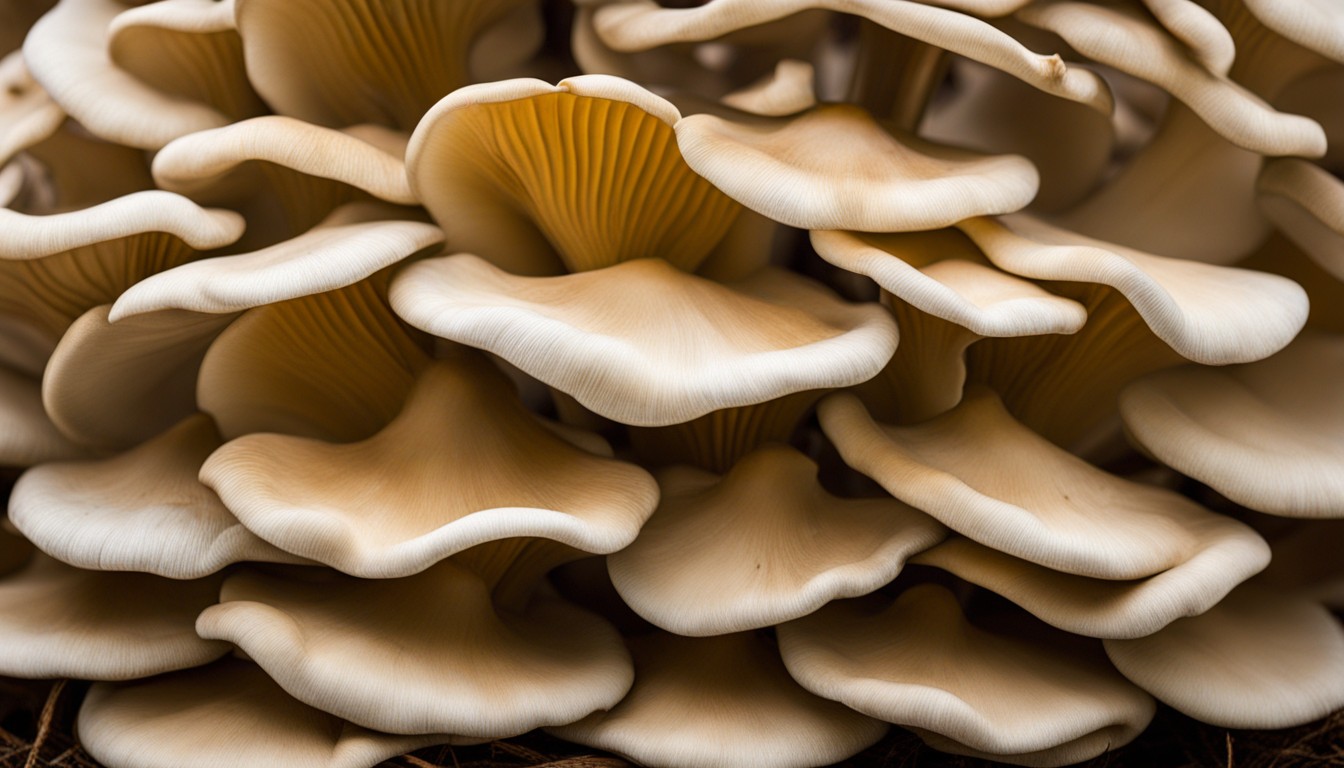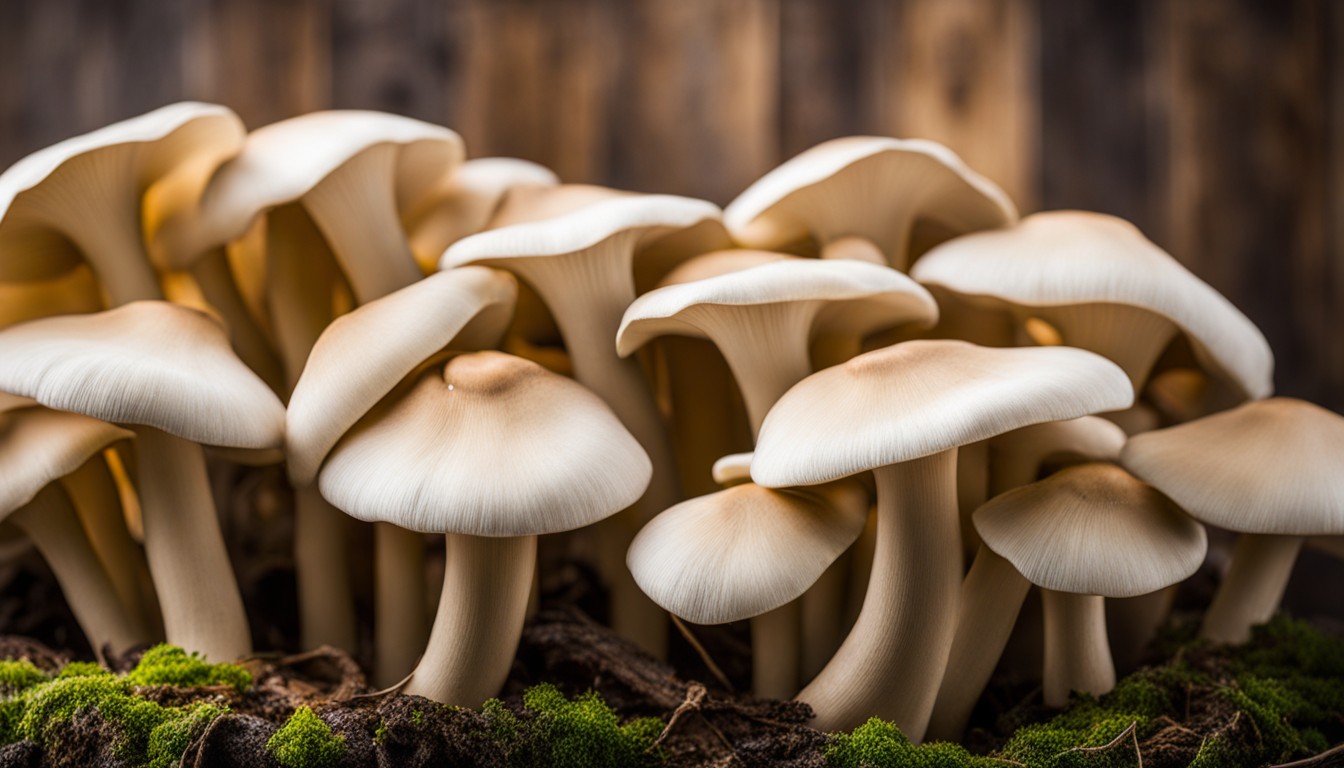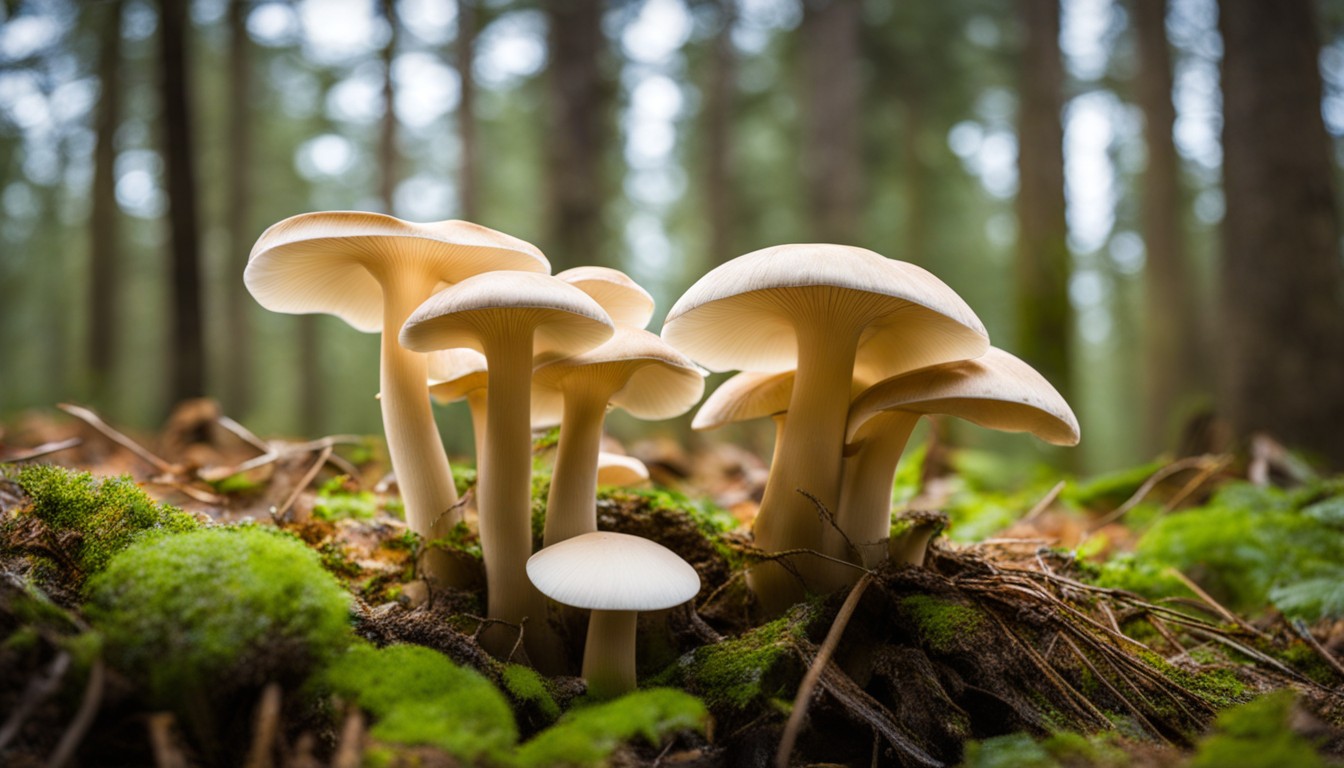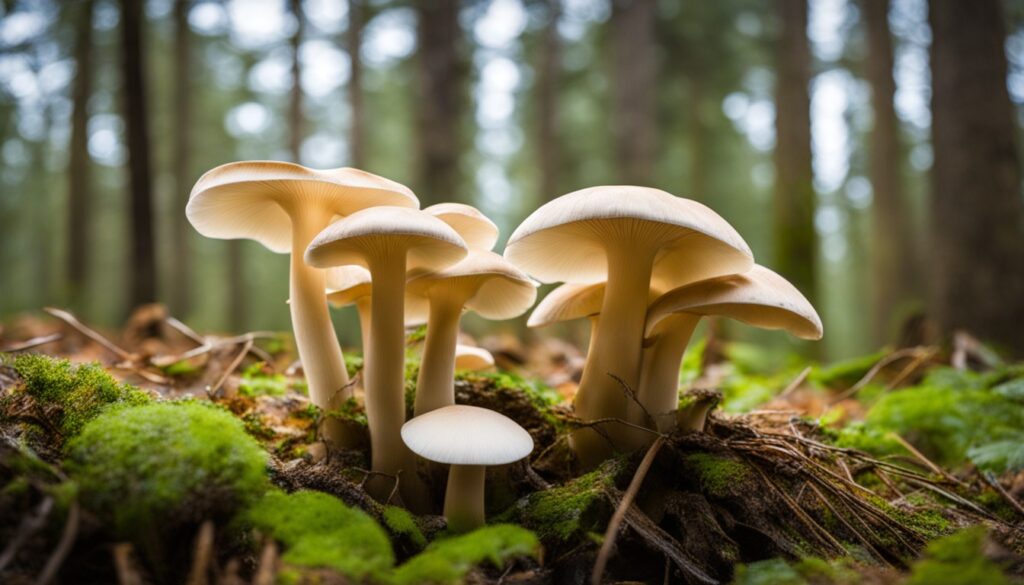Oyster mushrooms are a prized delicacy for food enthusiasts and foragers in Alberta, Canada. This blog post will guide you through the art of wild foraging for these delectable fungi, sharing tips on where to find them and how to prepare them.
Benefits of Oyster Mushrooms
Oyster mushrooms, a nutritional goldmine, offer a substantial source of dietary fibres, proteins and essential vitamins like B1, B3, B5, and D, bolstering the immune system. Boasting wide-ranging health benefits, they potentially aid in cholesterol management, boost brain health, and exhibit notable anti-inflammatory, anticancer properties when incorporated into a balanced diet.
Nutritional Value
Oyster mushrooms possess an impressive nutrient-loaded profile that justifies their hailed status amongst fungi. Rich in vitamins such as B-complex, C, and D, these mushrooms offer vital nutrients that bolster overall health.
Oyster mushrooms, renowned in fungi family, are not just sumptuous but a powerhouse of fitness, flourishing with vitamins, higher protein than most veggies & some meats, heart-supporting fibers, and essential minerals.
The protein content is noteworthy – higher than most vegetables and some meats. Packed with essential amino acids, they’re an excellent choice for vegetarians and vegans seeking alternative protein sources.
Oyster mushrooms also outshine other varieties in their fiber content; they are replete with beta-glucans, a type of soluble fiber known to support heart health. The fiber density aids digestion while adding a satiating quality to meals.
A weighty mineral profile rounds off oyster mushrooms’ nutritional value, delivering iron, potassium, zinc, and selenium. These minerals assist in maintaining balanced body functions, reinforcing the mushrooms’ position as a culinary and nutraceutical powerhouse.
Health Benefits
The oyster mushroom isn’t just a culinary delight. Packed with antioxidants, vitamins, and minerals, it holds potent transformative health properties. Regular consumption has shown to improve cardiovascular health, enhance immunity, and aid digestion.
Integrating oyster mushrooms into your menu offers more than just a flavor boost. It paves the way to optimal health, aids in maintaining a balanced diet, and provides your body with essential nutrients, making it a delicious ally in your well-being journey.
Wild Foraging of Oyster Mushrooms in Alberta

Alberta, with its diverse natural habitats, presents an ideal landscape for foraging oyster mushrooms. From the cool, shadowed woodlands to mossy river banks, these edible treasures lurk in the province’s damp and deciduous environments, waiting for an observant eye.
The thrill of identifying and collecting wild oyster mushrooms amplifies the joy of the hunt. Alberta’s lush forests suddenly transform into a gourmet’s playground, their hidden mushroom hoards a treasure-trove of culinary potential.
Ideal Locations for Foraging
Renowned for its fertile terrain and biodiversity, Alberta presents a myriad of locales suitable for foraging wild oyster mushrooms. Embarking on this woodland adventure, one can explore the mushroom bounty spread across Alberta’s enchanting landscape.
- Forests with deciduous trees, especially elm, aspen, birch, and poplar, yield a promising likelihood of encountering oyster mushroom clusters.
- Low-lying areas in the forest near creeks or rivers often harbor a wealth of oyster mushrooms.
- Well-shaded areas foster the growth of these mushrooms, ensuring a successful gather even during drier periods.
- Finally, north-facing slopes can be productive forage sites, as they retain moisture longer and provide a more conducive environment for mushroom growth.
Seasonal Availability
In Alberta, wild foraging of Oyster mushrooms is at its prime during the spring and fall months. Recognize the ideal harvest seasons, to yield these natural delicacies at their absolute best.
- Spring: Typically running from March to June. The fertile soil and mild temperatures create an ideal environment for sprouting.
- Fall: Oyster mushrooms make their comeback from September to November. The changing weather conditions, with cooler nights and frequent rainfall, make it the most bountiful season for these mushrooms.
Safety Precautions
When venturing into the wild to harvest Oyster mushrooms in Alberta, taking necessary precautionary measures is not optional but essential. Following these guidelines ensures a safe and productive foraging experience.
- Survey the site thoroughly before foraging to avoid harmful plants and wildlife.
- Always utilize field guides or apps to confirm the identity of your finds.
- Never consume a mushroom unless you are 100% sure of the species.
- Avoid harvesting alongside roadsides due to potential pollution and pesticides.
- Carry a first aid kit for any minor accidents or insect bites.
- Be prepared for weather changes – wearing layers and carrying proper gear is advised.
- Practice sustainable foraging by not overharvesting or damaging the natural habitat.
Identifying Oyster Mushrooms
Navigating the world of mushrooms in Alberta can be daunting. But, to correctly identify oyster mushrooms, rely on expert guides and a list of key traits for the best outcome.
Oyster mushrooms in Alberta display a variety of distinct features like a fleshy, deep cap, white gills that run down the short stem, and a faint anise-like aroma. Accuracy in identification ensures both safety and a pleasant culinary experience.
Distinct Characteristics
Oyster mushrooms in Alberta bear unique traits that separate them from many other fungus varieties. Shaped like an oyster shell or a fan, they vary in color from white and gray to pale yellow, depending on the season and their substrate.
One standout trait is their smooth texture. Oyster mushrooms tend to lack the rough and grainy surface seen in other fungi. Their caps are typically thin and delicate, often curling slightly at the edges, creating an inviting appearance.
Their structure follows a decentralized model, with no defined stem and cap axis. Instead, the caps attach themselves laterally on logs and trees, adding to their distinct look and aiding their identification.
Moreover, the gills are decurrent, meaning they extend down the stem. This feature presents a stark contrast to the bulging gills of some mushroom species, and it is always a good sign that you’ve found an oyster mushroom.
Lastly, a faintly sweet smell, reminiscent of anise or licorice, is often noted in fresh oyster mushrooms. This identifier can be particularly helpful for those new to mushroom foraging in Alberta, as it provides an additional clue to confirm their find.
Common Misidentifications
The risk of confusing oyster mushrooms with their lookalikes is significant, especially for novice foragers. Here are some common types that can easily mislead:
- Angel Wings: Resembling oyster mushrooms but thinner and smaller, these can be harmful if consumed in large quantities.
- Elm Oysters: Although edible, these lack the trademark decurrent gills of true oysters.
- Lung Oyster, usually found on coniferous wood instead of hardwood which is preferred by real oyster mushrooms.
- The poisonous Jack O’Lantern: Easily confused but has a much brighter orange hue and the gills don’t run down the stem as they do in oyster mushrooms.
Preparing Oyster Mushrooms

Mastering the art of preparing Oyster mushrooms is supremely rewarding. Start by gently brushing off any dirt, then rinse briefly and pat dry. Avoid soaking them, as these mushrooms absorb water quickly, heightening the risk of becoming mushy.
The key to preserving the richness of fresh Oyster mushrooms is in the cooking. Opt for high heat and a quick sauté to lock in their delicate flavor and aroma. Remember, overcooking can cause them to turn rubbery, thus exact timing is critical.
Cleaning and Washing
When it comes to cleaning oyster mushrooms, meticulousness matters. Dirt and debris can hide even in the folds of this delicate wild fungi, and improper cleaning can negatively impact the taste and texture of your dish.
- Start by gently brushing off visible dirt using a soft mushroom brush or a toothbrush.
- Avoid soaking in water as it can make the mushrooms soggy; use a slightly damp cloth to wipe if needed.
- You can also use a knife to scrape off stubborn dirt or to remove the base where it can often collect.
- A pair of kitchen shears can be handy for trimming any noticeably tough or chewy areas.
- Check the gills under the cap and the stem; these are prime spaces for hidden soil and small insects.
Cooking Techniques
When it comes to unlocking flavors in oyster mushrooms, innovative techniques such as pan-searing or grilling are a chef’s valuables. These methods allow for the mushroom’s subtle, yet savory flavors to be accentuated, turning a simple ingredient into a culinary star.
A favorite in many gourmet dishes, the oyster mushroom requires careful cooking to maintain its unique texture and taste. Techniques such as sautéing or baking allows one to enjoy it as a meat substitute in vegetarian and vegan dishes.
Elevating your culinary skills is effortless with oyster mushrooms. From roasting to stir-frying, experimenting with various cooking methods enhances not only the versatility of the ingredient but also its potential in stunning your dinner guests with an elevated dish.
Recipes Featuring Oyster Mushrooms
In Alberta’s culinary scene, Oyster mushrooms play a unique role, bringing distinct flavors and textures to various dishes. Their delicate yet earthy taste makes them a versatile ingredient in a myriad of recipes.
Recipes featuring wild Oyster mushrooms truly highlight the culinary treasures of Alberta. These dishes, be it a soup, stir-fry or risotto, not only offer hearty meals but also a savory exploration of the province’s rich biodiversity.
Creamy Oyster Mushroom Soup
Effortlessly creating a bowl of Creamy Oyster Mushroom Soup brings warming comfort on chilly Alberta nights. Simmer harvested oyster mushrooms in a rich mix of onions, garlic, and cream for a heartwarming delicacy to chase the cold away.
In every bowl of Creamy Oyster Mushroom Soup, experience the true taste of Alberta. Freshly foraged local oyster mushrooms magnify a classic creamy soup, offering depth of flavor that is beyond compare.
With just a handful of ingredients, it’s possible to deliver an extraordinary culinary experience. Using locally foraged oyster mushrooms, elevate traditional soup into something truly special, radiantly showcasing the unique flavor profile of Alberta’s wilderness.
Oyster Mushroom Stir-Fry
Overwhelmed by your mushroom haul? A simple stir-fry recipe can beautifully showcase oyster mushrooms in a delicious meal. Start by sautéing the mushrooms in a hot pan with some oil until they turn golden. Add in garlic, ginger, soy sauce, and a touch of sesame oil for a classic stir-fry that’s quick, delicious, and nutritious.
Upgrading your oyster mushroom stir-fry into an epicurean delight is easy and worthwhile. A key tip is to cook your mushrooms in batches, ensuring they’re properly browned and not overly crowded in the pan. This achieves a better texture and maximizes flavor infusion.
Even subtle enhancements can elevate your stir-fry. Opt for hand-picked wild garlic over farmed varieties for greater intensity. A sprinkle of toasted sesame seeds just before serving adds an enticing crunch.
Your oyster mushroom stir-fry can be versatile as complex or simple as you prefer. Toss in additional freshly foraged vegetables like bell peppers or snow peas for a vibrant mixed stir-fry, or serve the prepared mushrooms atop steamed rice or noodles for a satisfying meal.
Oyster Mushroom Risotto
Imagine presenting an aromatic dish to your dinner guests, their noses teased with the unique charm of wild Oyster Mushrooms. The hero of this gastronomic delight is none other than the ever-enchanting Oyster Mushroom Risotto – a recipe that never fails to leave every palate captivated.
In its essence, the allure of Oyster Mushroom Risotto lies not only in its unique taste but also in the creaminess – a texture achieved with slow-cooked Arborio rice and fresh Oyster mushrooms picked from the wild expanses of Alberta. The result is a stunning culinary piece that screams of elegance and sophisticated flavors.
For this splendid risotto, begin with sauteing the freshly foraged Oyster Mushrooms until they’re golden and deliver a nutty aroma. It’s crucial to add the mushrooms only after the rice absorbs the broth. This approach ensures both the rice and mushrooms retain their distinctive flavors when they finally merge.
Consider getting the Arborio rice to that ‘just right’ creaminess, an art of patience. It is essential to gradually add the chicken or vegetable broth, continually stirring to achieve the perfect creamy texture. It’s this meticulous process that creates a risotto with a melt-in-your-mouth consistency but still holding the crunch of the rice.
Lastly, as the risotto nears its completion, sprinkle in a hearty dose of Parmesan cheese. Stir it through until the risotto takes on a velvety character – a fitting curtain call to this Oyster Mushroom showstopper. Remember, the goal is not just to cook a meal but to create an unforgettable dining experience with Alberta’s wild Oyster Mushrooms.
Preserving Oyster Mushrooms

Preserving oyster mushrooms isn’t just about maintaining their taste, it’s about keeping their potency and nutritional benefit intact. One well-accepted method is drying, as it keeps the nutrients stable and mushrooms crunchy for long-term use.
Sustaining the freshness and keeping the flavor of foraged or bought oyster mushrooms is paramount. This can be efficiently achieved by freezing. Clean and blanch the mushrooms before submerging in cold water and then freezing, which locks in both their taste and nutrient profile.
Drying and Storing Methods
To extend your enjoyment of freshly foraged oyster mushrooms, employing tried and tested methods for drying and storing is crucial. Drying them in a dehydrator or an oven, then storing in air-tight containers can preserve their rich flavor and quality for up to a year.
Ensure a bountiful supply of this delicious fungi all year round by drying and storing your harvested oyster mushrooms effectively. Spread cleaned mushrooms on a tray, dry at low temperatures, and store them in a cool, dark place for the best long-term results.
Freezing for Long-term Use
Freeze Your Way to Longevity: The practice of freezing adds years to your harvest, delivering fresh flavor when you crave that earthy goodness. Quick freezing after harvest maximizes the nutritional content of oyster mushrooms, enhancing their shelf life significantly.
Lock in Freshness: For optimal results, spread cleaned, patted dry mushrooms in a single layer on a baking tray. Freeze until solid, then transfer to airtight freezer bags. This method ensures each piece freezes individually, preventing them from clumping together and maintaining their inherent freshness for longer.
Supporting Local Mushroom Foragers
Recognising and supporting the dedicated mushroom foragers of Alberta contributes to not only the local economy but also the sustainability of the environment and wildlife. Thus, consumers play a crucial role wherein their investment in such local produce spearheads this effort.
- Purchase oyster mushrooms from local farmers’ markets or stores supporting foragers.
- Participate in local foraging workshops or tours.
- Advocate for sustainable foraging practices within the community.
- Donate to community organizations supporting local foragers.
FAQ
What makes oyster mushrooms in Alberta so special?
Oyster mushrooms found in Alberta offer a unique culinary delight with their delicate flavor and meaty texture, making them highly sought after by food enthusiasts. Additionally, they are abundant in nutritional value, providing a rich source of essential vitamins, minerals, and antioxidants.
Where can I find oyster mushrooms in Alberta?
Oyster mushrooms can be found growing in various habitats in Alberta, including forests, woodlands, and even on decaying logs. Look for them during the spring and fall seasons, particularly after rainfall, as they tend to thrive in moist environments.
How do I properly harvest oyster mushrooms?
To responsibly harvest oyster mushrooms, gently twist and pull them from the base of the stem, ensuring that you leave a portion behind to allow for future growth. It is essential to handle them with care to prevent damage and maintain their quality.
Are there any look-alike mushrooms I should be aware of?
While oyster mushrooms have distinctive characteristics, it is always crucial to exercise caution when foraging. Some look-alike mushrooms, such as false oysters or poisonous species, may resemble oyster mushrooms. It is advisable to consult a reliable field guide or seek guidance from experienced foragers before consuming any wild mushrooms.
How should I store and prepare oyster mushrooms?
To prolong their freshness, store oyster mushrooms in a paper bag or breathable container and refrigerate them. When it comes to preparation, oyster mushrooms are versatile and can be sautéed, grilled, roasted, or incorporated into various dishes like soups, stir-fries, and pasta.
Can oyster mushrooms be cultivated at home?
Yes, oyster mushrooms can be successfully cultivated at home. With the right growing materials and techniques, you can create your own oyster mushroom growing environment and enjoy a steady supply of these delicious fungi throughout the year.
Conclusion
Reflecting on the joys and benefits of foraging for Oyster mushrooms, one realizes the symbiotic connection with nature. It feeds both the body and the soul, providing rich nutrients and the pleasure of the hunt. Further, these humble fungi demonstrate remarkable resilience, thriving in varied conditions.
The delightful journey of Oyster mushrooms, from foraging to table, unfolds a tale that is both edifying and delectable. Embarking on this journey not only puts us in touch with the rhythm of nature but also allows a discovery of remarkable culinary possibilities.
- Nurturing a symbiotic relationship with nature.
- Providing rich nutritional benefits.
- Enjoyment and thrill of the hunt.
- Learning about the resilience of fungi species.

